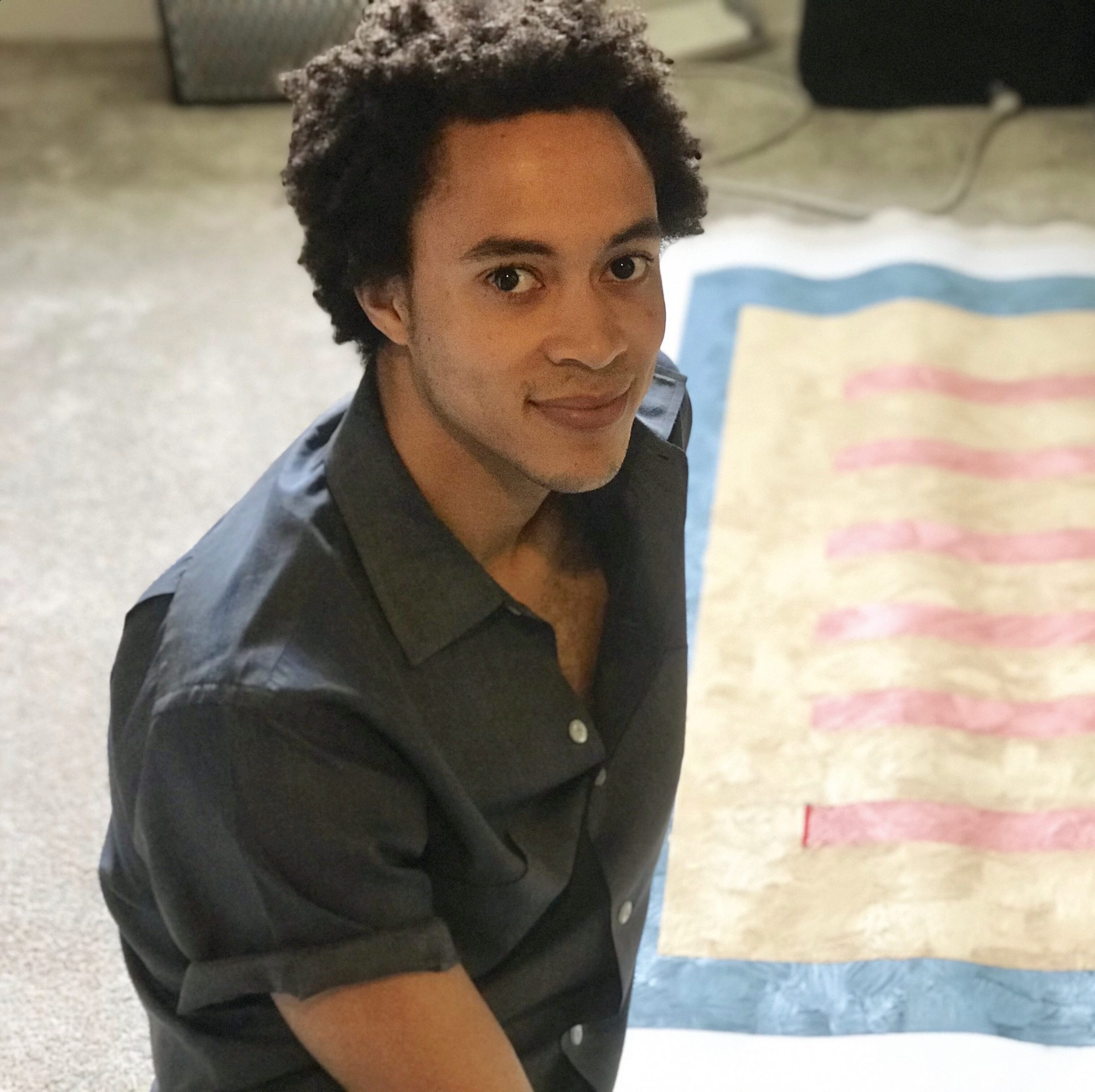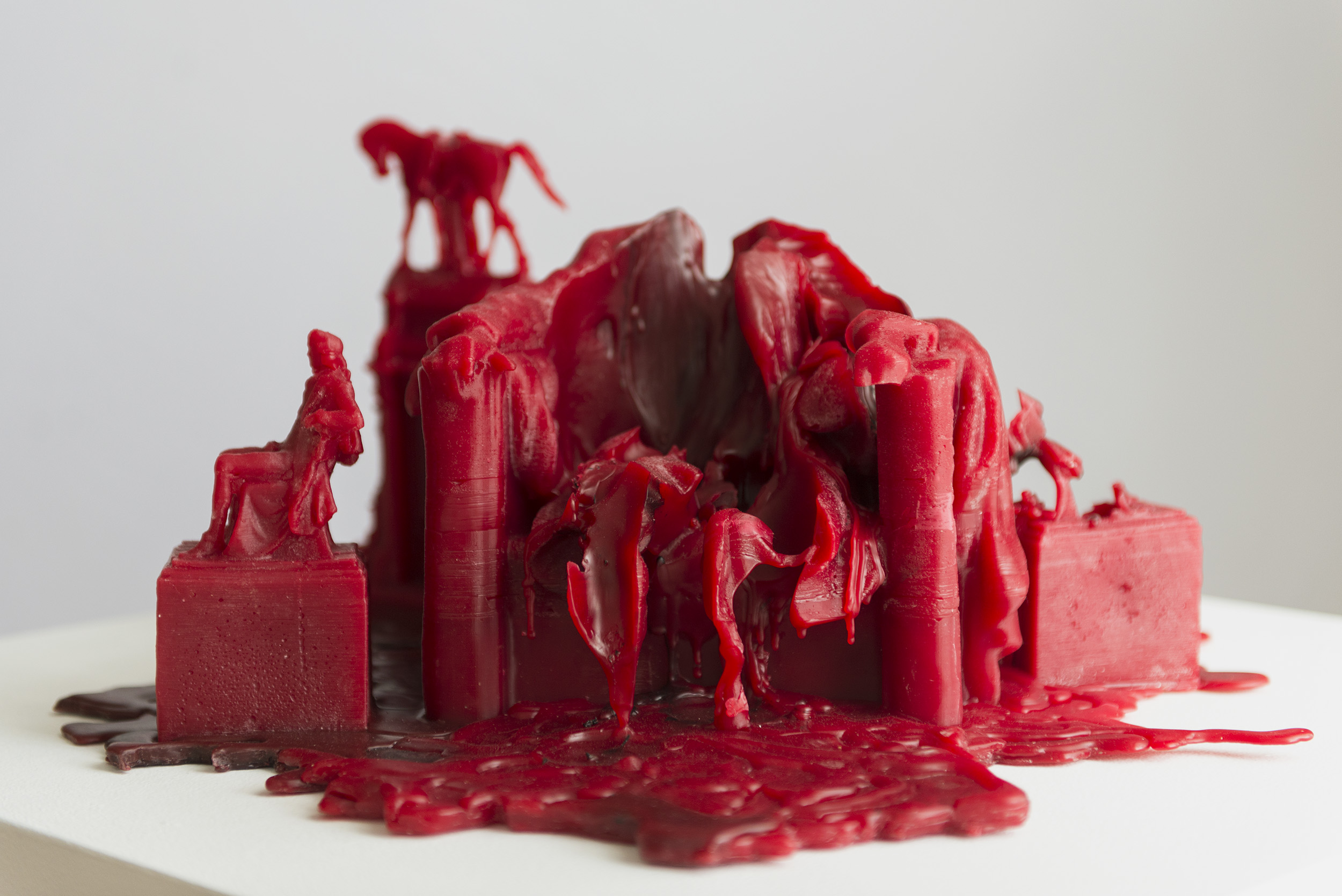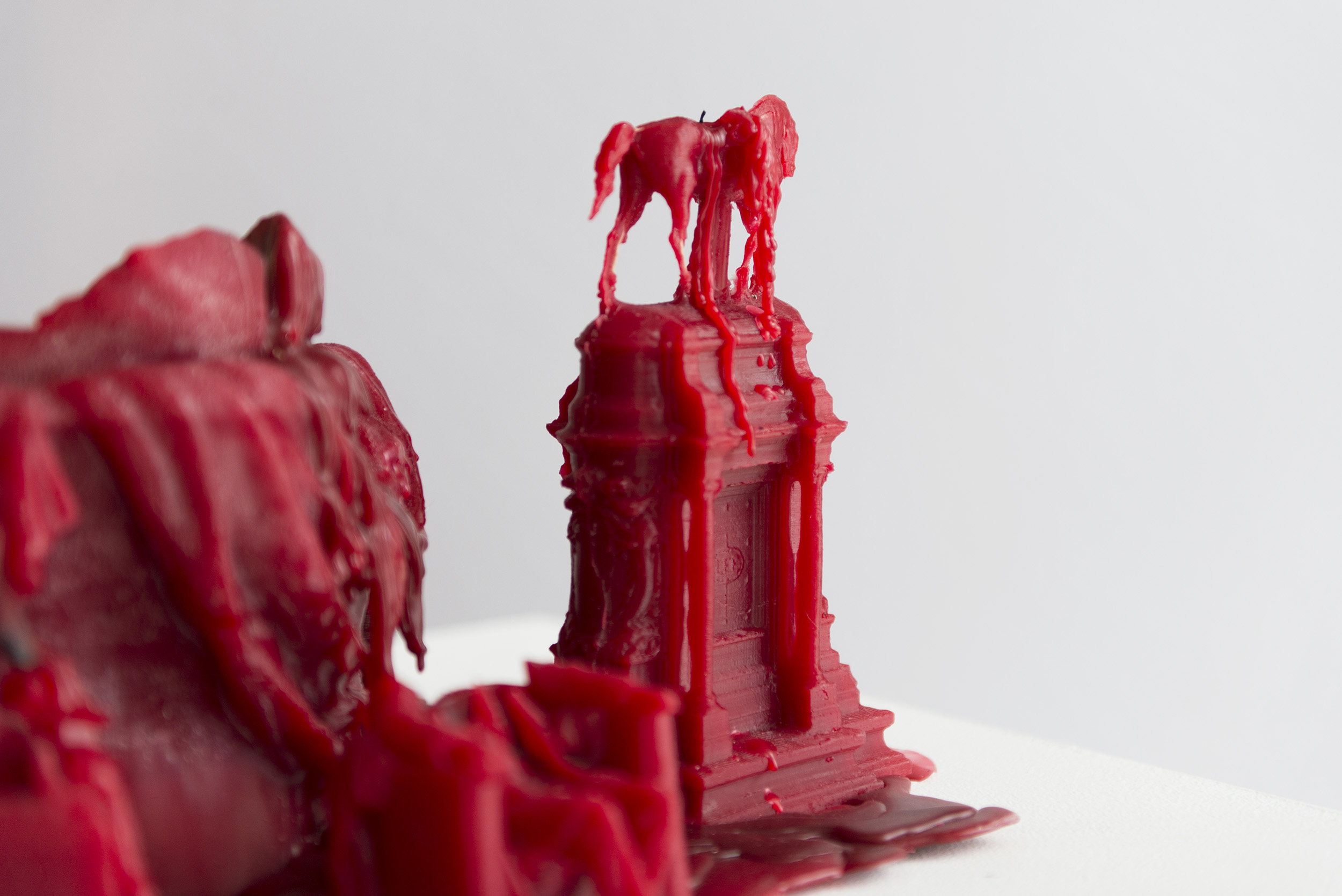In the Studio
“The candle, and the act of melting the form of the monument, works as both vigil and effigy. They incite both forward action and the backward bounce of reflection. The attention that a flame requires is a form of meditation, and through meditation we are able to conjure visions for the future.”
– Sandy Williams IV

Sandy Williams IV is a Richmond-based artist working in multiple media: sculpture, film, performance, painting, photography, text and the public. After graduating from The University of Virginia with his BFA in 2016, he moved to Richmond, receiving his MFA in Sculpture + Extended Media from VCUarts in 2019. For the past year he has taught at University of Richmond in the sculpture department and currently lives and works in Richmond.
Sandy’s work has continually addressed ideas of history, time and agency over ideas imbedded within both of those concepts. With recent work that resizes and deconstructs imagery of historically American monuments, Sandy’s practice proves particularly powerful and poignant in the context of the Black Lives Matter movement and removal of confederate monuments in and throughout Virginia. We’re thrilled to learn more about Sandy’s practice and background and celebrate a rising talent and voice.

Before Richmond, you lived and worked in Charlottesville...how has being here affected your practice?
Charlottesville is where I finished chemotherapy, attended college, and where I became an artist. It was an important period in my life when I was given space to be sick, feel hurt, make lifelong friends, heal, and become myself in a lot of ways. In Charlottesville I also experienced and witnessed a lot of injustice, specifically at - but certainly not limited to - the University of Virginia, and my last day living in Charlottesville, by certain coincidences and quick luck, was when white nationalists flooded the streets and killed Heather Heyer. Moving to Richmond in a lot of ways began a new phase for me. Richmond is bigger and more diverse; and by effect, I think the move widened my lens and the work I feel called to make.

Sandy in his bedroom studio
As a sculptor creating a diverse range of work, what does your studio look like?
I’m actually still looking for a studio, I haven’t had one for about a year now, so by necessity my “studio” is kind of everywhere. I make films and perform outside. I use my bedroom for the cleaner parts of my practice. I also work by planning and meditating on ideas, and I do a lot of that while walking, talking and traveling in the car. Additionally, as faculty at the University of Richmond I have access to a number of beautiful spaces and fabrication shops with essential resources that enable my experimental art practice.
What about your site-specific and performative work...do you consider these different spaces a part of your “studio” as well?
I think what is great about working in the public on site-specific projects is that it is very specifically not my studio. The studio can sometimes be like a bubble, which is important for nurturing certain ideas and spaces, but working within the public not only gives my work vital/different/immediate context, but it also gives “the public” the opportunity to be an audience, a witness, or sometimes even accomplices or performers within a choreographed series of simultaneous relationships – a performance – many elements of which are outside of my control.

A still from Sandy’s piece Five Years Later…, performed at VCU’s Institute for Contemporary Art in Richmond as a part of their Provocations Performance series in 2019.
Have you always worked in performative ways?
If you had asked me in high school what I would be doing now, I probably would have told you that I would go on to become a doctor or an orthodontist. When I dropped out of school after my first year of college, in order to finish chemo, I came back unfortunately uninterested in learning more medicine, and therefore desperately in search of new purpose, and I fell into art. In fact, I started taking art classes as a type of therapy, I had some amazing professors, and between then and now life has been somewhat of a whirlwind. I went from not really knowing anything about contemporary art to it being almost all I talk about. When I started, I wanted to know how to do and make everything, and because of this my practice has always been very interdisciplinary, blurring lines between film (video), sculpture, and performance.
See Sandy’s most recent performance HERE
Wax Monuments #01, 2020, wax, wick, 3D scan of the Lincoln Memorial in Washington DC, the Robert E.Lee Monument in Richmond, VA, and Thomas Jefferson Monument in Charlottesville, VA
Can you tell us about your recent Wax Monuments? When did this series begin?
I started the Wax Monument series in 2017, after witnessing so much violence at the Unite the Right Rally, which was centered around Charlottesville’s Lee monument. The Wax Monuments are small wax candles made from 3D scans of existing monuments, such as the Robert E. Lee on Monument Avenue. Monuments are often made to sit and collect a patina, withstanding change in order to maintain popular histories. As a sort of anti-monument, my sculptures are small, non-permanent, malleable, multiples. They give their holders agency over forms that exist in our public spaces, but until recently were untouchable by law. I am interested in building monuments meant to change with the physical and cultural landscapes that surround them, monuments able to keep a living record of activity. In the fall, I will be installing a large Wax Monument at Socrates Sculpture Park as part of a group show called MONUMENTS NOW.

What’s the significance of using candles?
The candle, and the act of melting the form of the monument, works as both vigil and effigy. They incite both forward action and the backward bounce of reflection. The attention that a flame requires is a form of meditation, and through meditation we are able to conjure visions for the future. The amazing propensity that wax has towards fluidity can also be understood very beautifully as a metaphor for the timelessness of evolution. To shrink down these bronze statues and pour them back to wax is a sort of slippage – much like time travel – turning back the clock, and returning these monuments to the malleable wax form that they short-lived before being permanently cast in bronze (via the “lost wax” process).


Recently, you installed and melted your wax monument on the confederate statues in Richmond. What did that mean for you?
I had already been making videos of my wax figures melting in front of the monuments they were modeled after, but after I saw the Lee covered in graffiti, I called a few of my friends to help me and went to the monument the next day to melt a candle right on the monument – something I was of course forbidden to do at any of the monuments I had visited previously, or prior to this community intervention. It was a moment of empowerment for me, and for a lot of people, and I think its effects are still in echo.
With performances and a few interactive pieces, like "Unattended Baggage," accessibility seems to be a crucial theme to your work. How does the viewer engage with your work?
I like that you asked me to touch on this topic, because yes(!), a lot of my work is meant to be touched/ held/ owned/ felt. I like helping people experience the power I felt standing on that monument, to feel like they control a piece of destiny. The Unattended Baggage (Time Capsules) I and II are good examples of that. The timers on these suitcases have the potential to count up from 0 to 100 days. Equipped with motion sensors, their clocks reset whenever these bags are moved or unplugged. The clocks therefore tell you how long these objects have gone untouched, allowing them to keep track of their exact time in a specific place, and gathering the inertia of stored time as they sit. To touch one of these bags after any period of time is a moment of agency, which feels especially important if they have been sitting for a few days. Same thing can be said for the melting of a candle.
Where do your ideas come from for such conceptual works?
I really draw inspiration from everywhere. From the music I listen to, the news I hear, to the people whom I allow to influence me. My friends, mentors and family are constantly inspiring me to do more. Art began for me as an academic pursuit, so I also get a lot of inspiration by reading and doing research, two things that allow me to better understand the world I am living and working in. I think I get a lot of inspiration just by trying to pay attention.

Unattended Baggage I, 2017, suitcase, timer, accelerometer.
Unattended Baggage II, 2017, backpack, timer, accelerometer. Both in collaboration with Jack Doerner.
What is the importance of family in your practice? How does identity play into your work?
I gather so much of my sense of self by learning about my family. The more I get to know about the people in my family – both those that I know and the ancestors that I never met – then the more I get to know about myself. So the formation of identity in my work informs itself through an understanding of my personal and family history. Of course my identity is also informed through an understanding of regional, national, and global histories and the more I know about history. A lot of my more recent work has been to learn, mix, or insist that these histories all be thought of as in parallel, and with equal importance, without pejorative ideologies being able to oppress or suppress one by putting the other on a pedestal. That American histories and African American histories and contemporaneities are part of the same thing, and shouldn’t be taught, thought of, or shown separately or in different rooms.

I Get It From My Mama, 2018, black & white photographs of Sandy’s grandmother, mother, and himself, riding horses in Virginia – over a span of many decades – in the same manner so many figures sit atop monuments.
What can you teach us about Black liberation?
I think to really understand my work you have to understand that I am a nerdy, Black, North American, cancer surviving, artist, poet, student, professor, human being. All of these things inform my perspective, my voice, and the things that I take interest in. It would be a mistake to overlook the Blackness of my work, but it would be worse to misinterpret my work as being within a binary that only deals with Black(White) issues. I am complex, and so follows the work. I think Black liberation includes a true, deep, felt, meaningful, excited embrasure of the idea that all of these things are related; that we are all related not separate, and therefore those of this human family with privilege are responsible for the care and elevation of the others, in order to level this playing field that has been so historically uneven.
Sandy Williams IV received his BFA from The University of Virginia in 2016 and his MFA in Sculpture + Extended Media from VCUarts in 2019. He has held teaching positions at VCUarts and The University of Richmond, where he is currently an adjunct professor in the sculpture department. His work has been shown at Guadalajara 90210, Mexico City, Mexico; Public Pool Gallery, Los Angeles, CA; The Virginia Museum of Contemporary Art, Virginia Beach, VA; Co-Prosperity Sphere, Chicago, IL, and a forthcoming group exhibition at Socrates Sculpture Park, New York, NY.






